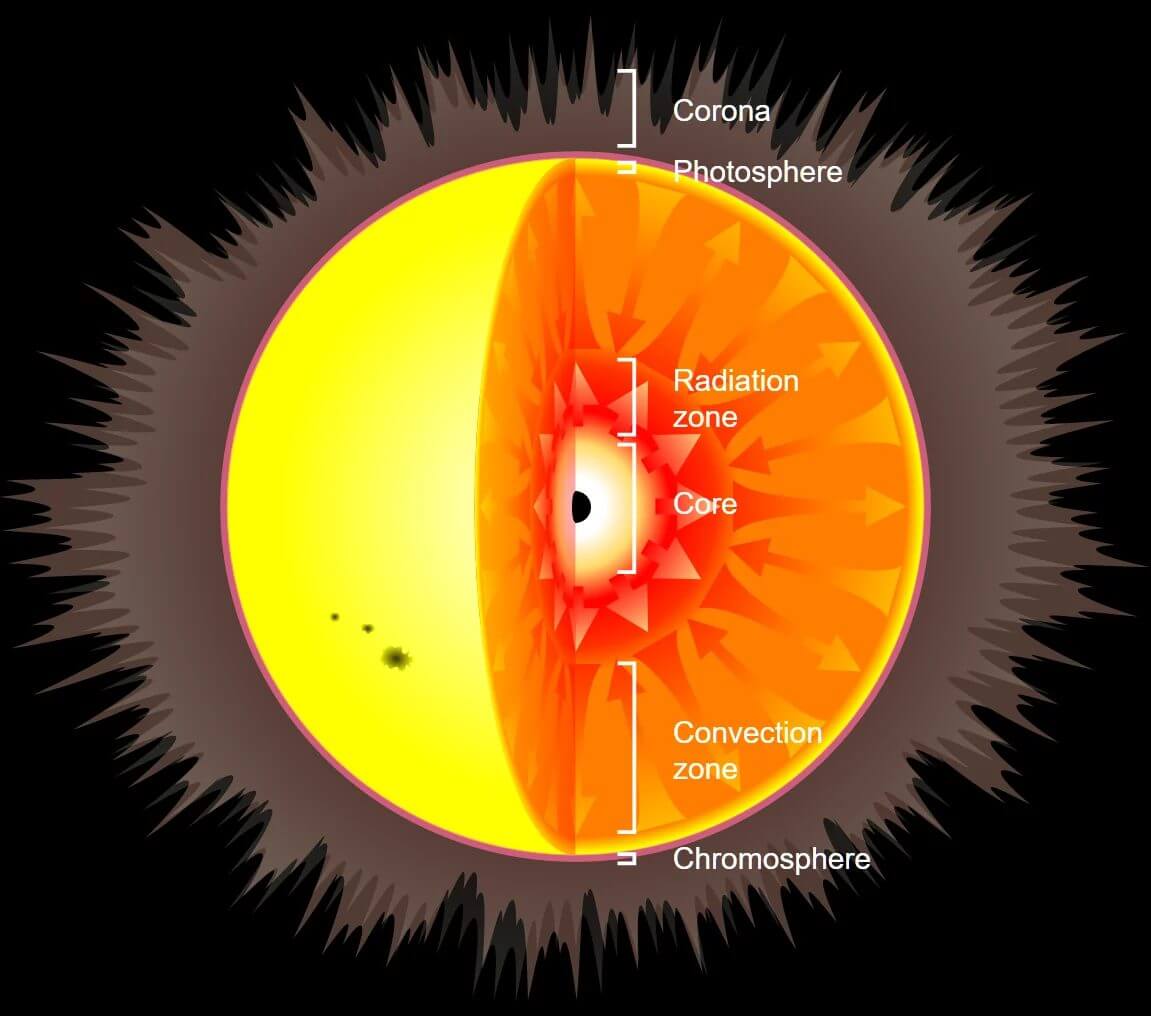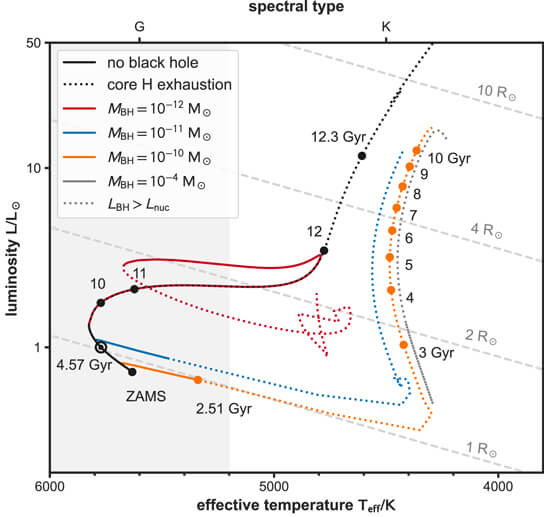Immediately after the birth of the universe, a very small mass of…Primordial black holeThere is a theory that it was created, but none of the actual objects have been discovered yet. So, what would happen if a star captured a primordial black hole and kept it at its center?
A research team led by Earl B. Bellinger of the Max Planck Institute for Astrophysics simulated the effects of assuming a primordial black hole at the center of the Sun. Results,If the primordial black hole was small, it could exist without any noticeable changes in the Sun.I understand that. It has also been found that certain conditions can cause changes in stars, so it may become possible to estimate the number of primordial black holes indirectly by observing the stars.

[▲الشكل 1: رسم تخطيطي لنجم هوكينج مع وجود ثقب أسود بدائي في مركز النجم (مصدر الصورة: معهد ماكس بلانك للفيزياء الفلكية)]
■ What is a primordial black hole?
「Primordial black hole“It is an extremely small black hole that is believed to have been created in a locally dense space in the universe shortly after its birth. A normal black hole has a mass of several times the mass of the Sun, but primordial black holes are much smaller than the mass of a star, and the smallest are thought to have the mass of a small mountain.”(※).
*Theoretically, the mass of the primordial black hole is thought to be greater than approximately 0.02 mg (Planck mass). However, as time passes from the birth of the universe to the present, the mass of primordial black holes that have survived to this day is thought to be about 10 million tons or more, as they lose mass due to Hawking radiation.
The primordial black hole isOne candidate for the mysterious source of gravity is “dark matter,” which cannot be observed by any means other than gravity.He is. Unlike many other dark matter candidates, primordial black holes have the advantage that their existence can be postulated without rewriting modern physics theory. On the other hand, we have not yet succeeded in observing primordial black holes, and it is not known whether they actually exist, and if so, how many there are.
■Even if there was a primordial black hole in the sun, would we not notice it?
Bellinger's research team simulated whether the presence of a primordial black hole inside a star would affect the star's evolution. The possibility that stars contain primordial black holes was suggested by Stephen Hawking in 1971, and Bellinger and his colleagues proposed calling these types of stars “Hawking stars.”
The case in which a star absorbs a primordial black hole is thought to be rare, but if it did happen, the primordial black hole would gradually fall into the center of the star, where it would gradually engulf the star and grow. However, the radiation at the star's center is very strong, and most of the material moves through the primordial black hole's gravity, so the star is thought to be consumed only very slowly.
Bellinger and his colleagues studied how the Sun's properties and evolution would change if it absorbed a primordial black hole. By performing simulations of primordial black holes of different masses, we can investigate whether the Sun's behavior deviates from the standard situation.
As a result of the simulation,If the mass of the black hole inside the star is less than 1/1 millionth of the mass of the Sun (about 1/3 the mass of the Earth), there will be no noticeable effect on the brightness of the Sun or the amount of neutrinos produced. .It turns out that. The possibility of the birth of a primordial black hole with this mass is also being theoretically considered.


[▲Figure2:TimeserieschangesinthebrightnessoftheSunbetweennormal(left)andwhenthereisaprimordialblackholeatitscenter(right)withamassof1/100billiontimesthemassoftheSunThebrightnessofordinarystarsincreasesgraduallyevenbeforetheybecomearedgiantbutinthecaseofaprimordialblackholethebrightnessincreasesmorequicklyafternuclearfusionstops[▲الشكل2:تتغيرالسلاسلالزمنيةفيسطوعالشمسبينالوضعالطبيعي(يسار)وعندمايكونهناكثقبأسودبدائيفيمركزها(يمين)كتلته1/100مليارمرةكتلةالشمسيزدادسطوعالنجومالعاديةتدريجيًاحتىقبلأنتصبحعملاقًاأحمر،لكنفيحالةالثقبالأسودالبدائي،يزدادالسطوعبسرعةأكبربعدتوقفالاندماجالنووي
However, even if there are no noticeable effects now, the Sun's future will change dramatically depending on the weight of the primordial black hole.
According to the standard theory of stellar evolution, the Sun will become a red giant star about 7 billion years from now (about 12 billion years after its birth), and after its outer layer expands to the point that it engulfs the Earth, it will gradually move away, and eventually it is believed that it will leave behind a white dwarf. .
In a scenario in which a primordial black hole with a mass of 1/100 billion times the mass of the Sun (compared to the mass of large asteroids and satellites) exists at the center of the Sun immediately after its birth, about 1.4 billion years from now (the Sun's birth is about 7 billion years from now), It is believed that the mass of the black hole has increased to 1/1000 of the mass of the Sun. The sun, which stops its nuclear fusion due to the loss of matter in its core, turns into a black hole. The sun’s brightness is due to the flow of matter that was sucked into the black hole (cumulative Bondi flow), which causes the sun to appear to become brighter due to nuclear fusion, and it will Better than when it was bright.
In addition, large amounts of helium will be detected at the surface, as partial fusion near the core will cause convection from the core to the surface. Due to this convection, the Sun expands to a much smaller size (about 4.5 million km) than the red giant star assumed by traditional stellar evolution theory. Earth will avoid the fate of being swallowed by the sun, but it seems inevitable that increased radiation will heat the oceans to boiling point.
On the other hand, in a scenario in which we start with a primordial black hole 10 times larger than the previous one (1/10 billion of the mass of the Sun), the Sun will be replaced by a black hole about 2 billion years after its birth. Simulation results show that “if the mass of the absorbing black hole is less than 1/1 millionth of the mass of the Sun, it will have no observable effect.” If the mass of the black hole is 1/10 billion of the mass of the sun, the sun will turn into a black hole within 2 billion years. Therefore, even if there was a black hole of this mass in the center of the sun, it would be absorbed immediately after its birth, and it turns out that it was not so.
Conversely, if the scenario starts with a primordial black hole with a mass of one-tenth the mass of the first scenario (one trillionth of the mass of the Sun), the effects will not appear until after it evolves into a red giant, so the effect is expected to be smaller for smaller primordial black holes. . However, more research will be needed to assess the exact extent of the effect, as it will require a closer look at the later stages of a star's evolution, which can change dramatically over a short period of time.
■ We may be able to detect primordial black holes at the centers of stars in the future


[▲Figure3:Changesinradiationintensityandsurfacetemperaturewhenthereisaprimordialblackholeatitscenter(redblueyellowandgray)comparedtoaregularblackhole(black)Becausetheyareararetypeofstarthatdeviatesfromnormalstellarevolutionduringitsevolutionitcanbediscoveredthroughobservationinthefuture(Imagesource:EarlPBellingeretal)[▲الشكل3:التغيراتفيشدةالإشعاعودرجةحرارةالسطحعندمايكونهناكثقبأسودبدائيفيمركزه(الأحمروالأزرقوالأصفروالرمادي)مقارنةبنجمعادي(أسود)ولأنهموجودكنوعنادرمنالنجومينحرفعنالتطورالنجميالطبيعيأثناءتطوره،فمنالممكناكتشافهمنخلالالمراقبةفيالمستقبل(مصدرالصورة:EarlPBellingeretal)
This research shows that a change in the properties of the star that became a Hawking star may lead to the discovery of a Hawking star, and may indirectly lead to the discovery of a primordial black hole. Stars absorbed by primordial black holes develop luminosity and temperatures similar to rare types of stars called quasigami stars and extreme red stars in their later stages of evolution, this study has revealed. These stars have been studied in detail, and it is also known under what environmental conditions these types of stars appear. This means that if these types of stars are found in non-standard environments, they could be stars that absorbed primordial black holes. Indirectly, the search for Hawking stars may become an important factor in estimating the number of primordial black holes.
but,The probability of a star absorbing a primordial black hole is currently considered very low, so more detailed investigation is needed to determine whether the star actually contains a primordial black hole and becomes a Hawking star.it will be. In the case where a star collides with a primordial black hole, we must assume that their velocities relative to each other are very slow. A typical primordial black hole has a very high velocity, so the probability of this condition occurring is thought to be very low.
Furthermore, even if a primordial black hole were to merge into a star, it is estimated that it would take a significant amount of time for the primordial black hole to fall into the center of the star. Primordial black holes are very small and experience little drag that slows them down and causes them to fall into the core. Furthermore, stars have a low density of matter outside their cores, and primordial black holes absorb very little matter, so they have little effect on star evolution. Because of this slow progress, it is possible that the star will reach the end of its life before the primordial black hole falls into its heart.
On the other hand, Bellinger and his colleagues also showed that it is possible to find Hawking stars using the method of “astroseismology”, which is the unique oscillations of stars. Since the effects of primordial black holes cannot be easily seen on the surface of stars, the method of astroseismology, which allows us to learn about the interior of stars, may be useful in the search for Hawking's star. However, because this method was invented recently, more research will be needed to determine if it can be used in practice.
source
Written by Riri Aya

“Travel maven. Beer expert. Subtly charming alcohol fan. Internet junkie. Avid bacon scholar.”






More Stories
Enjoy a hot cigarette while looking at whales and tropical fish under the sea ⁉︎ “Ploom Dive” is an amazing spatial video experience using Apple Vision Pro
Apple Watch now supports sleep apnea, watchOS 11 released – Impress Watch
ASCII.jp: New macOS Release! macOS Sequoia 15 Can Display Your iPhone Screen on Your Mac!